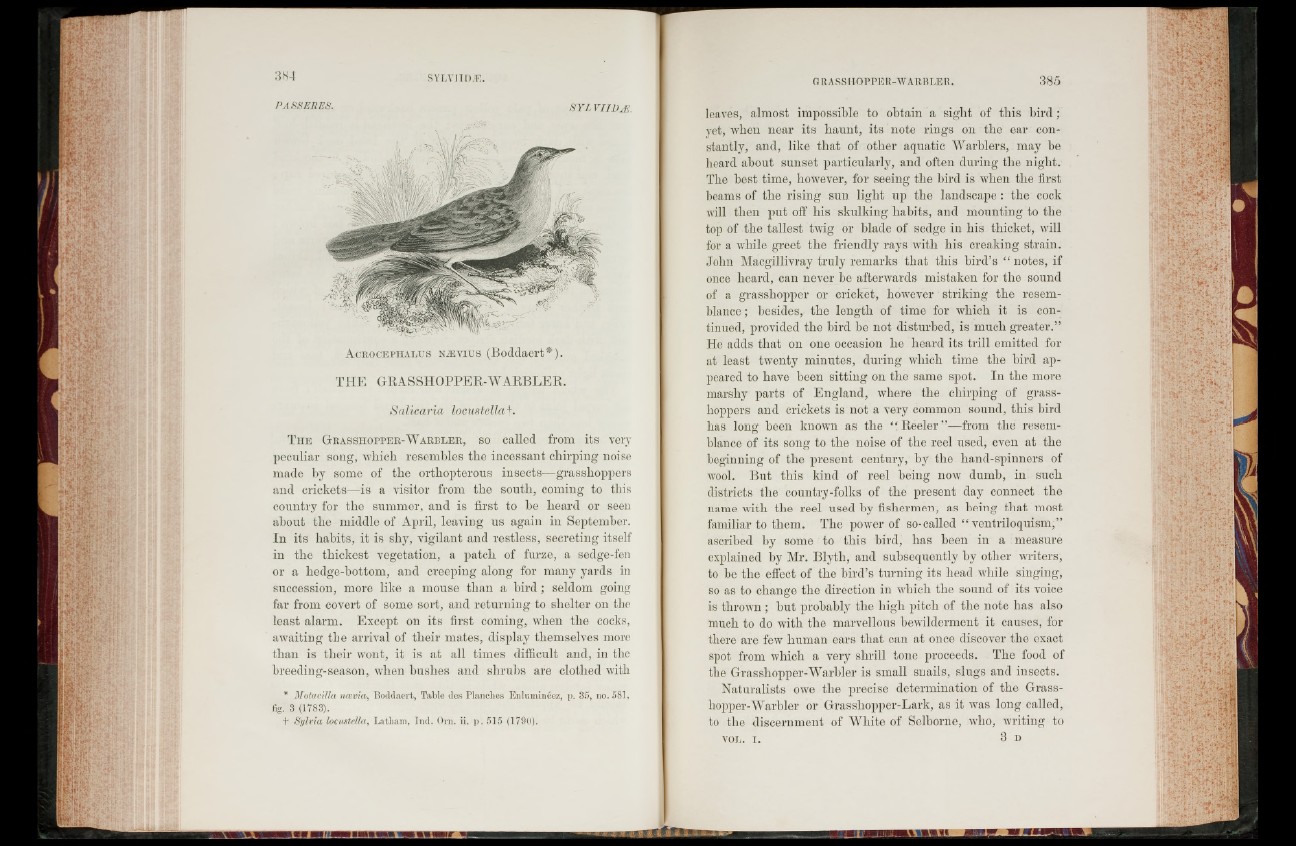
384 SYLV1 ID.TI.
A c r o c e p h a l u s NíEv iu s (Boddaert*).
THE GRASSHOPPER-WARBLER.
Salicaria locustella\.
T h e G r a s s h o p p e r -W a r b l e r , so called from its very
peculiar song, which resembles the incessant chirping noise
made by some of the orthopterous insects—grasshoppers
and crickets—is a visitor from the south, coming to this
country for the summer, and is first to be heard or seen
about the middle of April, leaving us again in September.
In its habits, it is shy, vigilant and restless, secreting itself
in the thickest vegetation, a patch of furze, a sedge-fen
or a hedge-bottom, and creeping along for many yards in
succession, more like a mouse than a b ird ; seldom going
far from covert of some sort, and returning to shelter on the
least alarm. Except on its first coming, when the cocks,
awaiting the arrival of their mates, display themselves more
than is their wont, it is at all times difficult and, in the
breeding-season, when bushes and shrubs are clothed with
* Motacilla n a s v iaBodclaert, Table des Planches Enlumincez, p. 35, no. 581,
fig. 3 (1783).
t Sylvia locustella, Latham, Ind. Orn. ii. p. 515 (1790).
\ \ ^ i l l ui i > \ i \ m i i i
G RA SS liOPPE ll-W A R BLE R. 385
leaves, almost impossible to obtain a sight of this bird ;
yet, when near its haunt, its note rings on the ear constantly,
and, like that of other aquatic Warblers, may be
heard about sunset particularly, and often during the night.
The best time, however, for seeing the bird is when the first
beams of the rising sun light up the landscape : the cock
will then put off his skulking habits, and mounting to the
top of the tallest twig or blade of sedge in his thicket, will
for a while greet the friendly rays with his creaking strain.
John Macgillivray truly remarks that this bird’s “ notes, if
once heard, can never be afterwards mistaken for the sound
of a grasshopper or cricket, however striking the resemblance
; besides, the length of time for which it is continued,
provided the bird be not disturbed, is much greater.”
He adds that on one occasion he heard its trill emitted for
at least twenty minutes, during which time the bird appeared
to have been sitting on the same spot. In the more
marshy parts of England, where the chirping of grasshoppers
and crickets is not a very common sound, this bird
has long been known as the “ Reeler”—from the resemblance
of its song to the noise of the reel used, even at the
beginning of the present century, by the hand-spinners of
wool. But this kind of reel being now dumb, in such
districts the country-folks of the present day connect the
name with the reel used by fishermen, as being that most
familiar to them. The power of so-called “ ventriloquism,”
ascribed by some to this bird, has been in a measure
explained by Mr. Blyth, and subsequently by other writers,
to be the effect of the bird’s turning its head while singing,
so as to change the direction in which the sound of its voice
is thrown ; but probably the high pitch of the note has also
much to do with the marvellous bewilderment it causes, for
there are few human ears that can at once discover the exact
spot from which a very shrill tone proceeds. The food of
the Grasshopper-Warbler is small snails, slugs and insects.
Naturalists owe the precise determination of the Grasshopper
Warbler or Grasshopper-Lark, as it was long called,
to the discernment of White of Selborne, who, writing to
VOL. I. 3 d